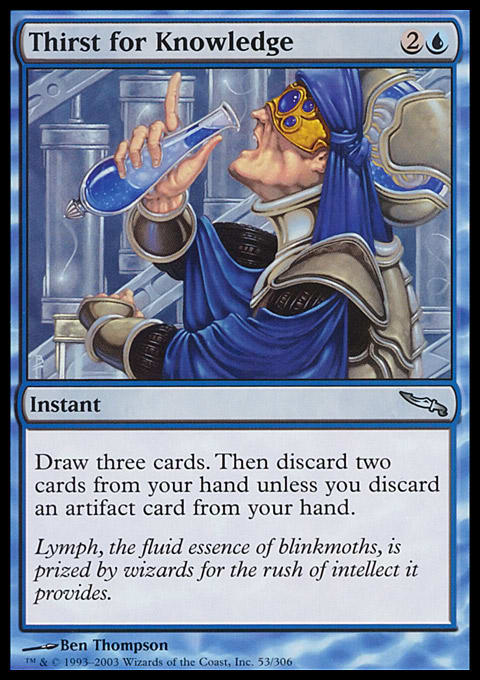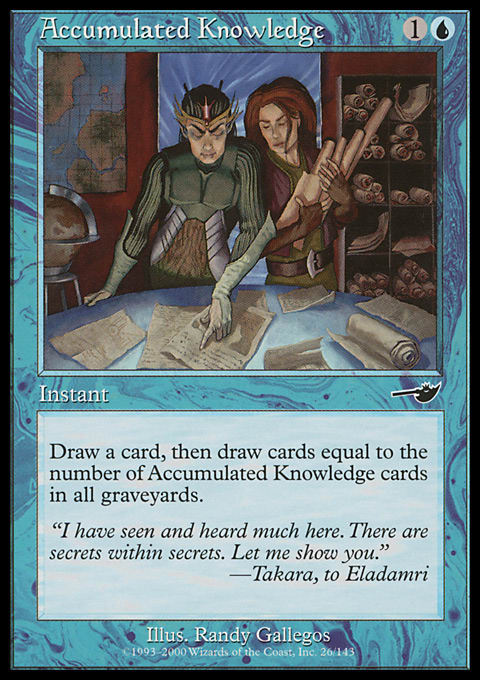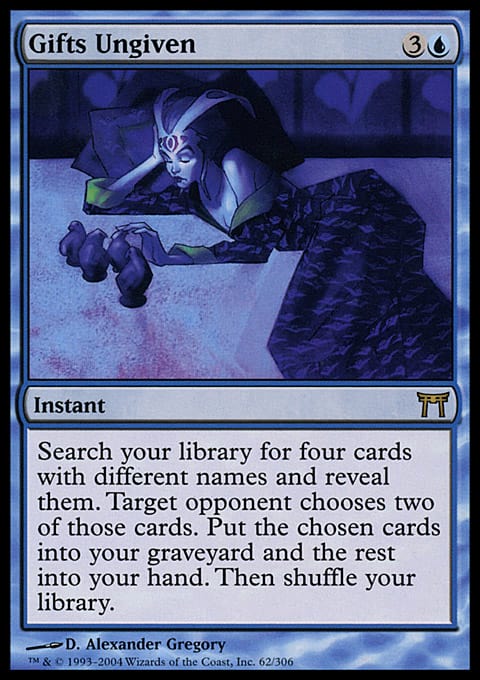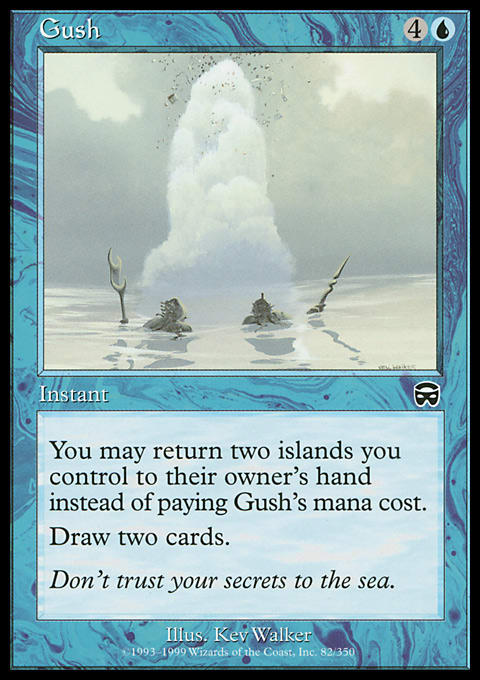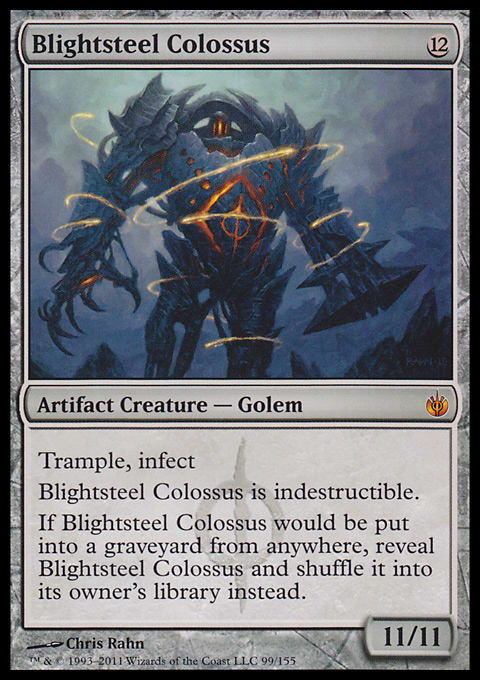Much of the work being done in Vintage Magic: The Gathering right now is focused on Thirst for Knowledge. With the recent unrestriction of that powerful and nostalgic draw engine, along with the restriction of Chalice of the Void encouraging players to once again brew with cheap artifacts, players are simply eager to see how Thirst and its decks compare with the rest of the format. A lot has changed since June 2009 . . .
Pop Quiz, Hot Shot: who can tell me what these cards have in common?
(aside from being Vintage playable and awesome) pic.twitter.com/EmVCMjTQLb
— Kevin Noël Cron (@kevincron) October 1, 2015
For example, all of those cards were printed.
Perhaps not all of them are especially relevant to Thirst, but things like Snapcaster Mage, Deathrite Shaman, and the delve spells might appreciate a new discard engine; Young Pyromancer and Monastery Mentor play well with card-draw; and Lodestone Golem, Dack Fayden, and Notion Thief can prey on Thirst in one way or another. None of these is hugely good or bad for Thirst’s success, so the potential is here for the twelve-year-old, six-year-restricted card to make a comeback.
Can Thirst decks compare to Gush decks?
How will Thirst stand up against Lodestone Golem?
Will decks look like they did in 2008, before Thirst’s restriction, or will there be something new?
Will this finally allow Control Slaver aficionados to resurrect that deck?
Is Thirst even going to make a long-term impact?
Back in the Day
Thirst for Knowledge made its debut in September 2003 in Mirrodin. That set—the whole block, actually—was earthshaking in Vintage. Go figure: A world of artifacts would make such an impact on a format that has always included artifact mana producers and Mishra's Workshop.
Chalice of the Void, Duplicant, Platinum Angel, Goblin Charbelcher, Isochron Scepter, and Mindslaver were printed and played. Chrome Mox was restricted almost immediately (and eventually unrestricted in 2008). Thoughtcast has been a strong draw spell, especially in the face of recently printed situational counters, and Sculpting Steel received new attention when Lodestone Golem was printed.
Trinisphere came out five months later in Darksteel with Aether Vial, Arcbound Ravager, and Skullclamp. Sword of Fire and Ice was popular in Workshop aggro and some creature decks. Darksteel Colossus became the Tinker target, and Sundering Titan worked alongside Goblin Welder to shred mana bases. Serum Powder would be part of Dredge forever, once Ravnica: City of Guilds was released.
In Fifth Dawn, Night's Whisper and Engineered Explosives were printed, and Crucible of Worlds was the second “You Make the Card” winner, designed by Magic players through Wizards’s website. Trinket Mage was printed along with Auriok Salvagers and the Bomberman combo.
For a format as large and staid as Vintage, this is a ton of playables, and there are some that I haven’t listed for one reason or another. Thirst for Knowledge was identified as playable almost immediately and started making Top 8 appearances alongside Goblin Welder in both blue-based Mindslaver control decks and Stax decks with Smokestack and Tangle Wire. Goblin Welder and Thirst seemed to be like Romeo and Juliet, even if their supporting cast was variable.
This December 2003 list from the Duelmen series of tournaments in Germany is the earliest Top 8 list with four Thirsts on Morphling.de, but it is fairly typical of the early Slaver decks:
Dulmen Slaver ? Vintage | Kim Kluck
- Creatures (6)
- 1 Gorilla Shaman
- 4 Goblin Welder
- 1 Pentavus
- Spells (36)
- 1 Ancestral Recall
- 3 Fire // Ice
- 4 Brainstorm
- 4 Force of Will
- 4 Mana Drain
- 4 Thirst for Knowledge
- 1 Demonic Tutor
- 1 Mind Twist
- 1 Time Walk
- 1 Tinker
- 1 Yawgmoth's Will
- 1 Black Lotus
- 1 Memory Jar
- 1 Mind's Eye
- 1 Mox Emerald
- 1 Mox Jet
- 1 Mox Pearl
- 1 Mox Ruby
- 1 Mox Sapphire
- 1 Sol Ring
- 2 Mindslaver
- Lands (19)
- 1 Island
- 1 Library of Alexandria
- 1 Strip Mine
- 1 Wasteland
- 2 Polluted Delta
- 3 Flooded Strand
- 3 Underground Sea
- 4 Volcanic Island
- 1 Tolarian Academy
- 2 Seat of the Synod
- Sideboard (15)
- 4 Chalice of the Void
- 1 Mind's Eye
- 3 Rack and Ruin
- 3 Red Elemental Blast
- 3 Tormod's Crypt
- 1 Vampiric Tutor
The idea with this and later versions of Slaver was to establish control and eventually use Tinker, Goblin Welder, Mana Drain, or superior mana to put Mindslaver into play. Mindslaver could then wreck an opponent’s day as you played the worst Magic possible, making the opponent tutor for nothing, target you with Ancestral Recall, burn counters on his or her own spells, and so on. If you could put Mindslaver, Welder, and Pentavus together, you could take all of your opponent’s turn for him or her. This lock was especially poignant in the mirror match, wherein you could potentially use your opponent’s Welder to bring your Mindslaver back. Eventually, your advantages would add up, and you would win by concession or attacks.
Stax, the Mishra's Workshop control deck based around Smokestack and Tangle Wire, had used Meditate as a way to both draw cards and skip turns and thereby avoid the upkeep effects from its artifacts. Thirst was identified as a replacement, again because of its Welder synergy and since (despite Meditate’s “benefit”) it wouldn’t require skipping a turn.
5C Stax ? Vintage | Kevin Cron
- Creatures (4)
- 4 Goblin Welder
- Spells (39)
- 1 Ancestral Recall
- 3 Thirst for Knowledge
- 1 Demonic Tutor
- 1 Mind Twist
- 1 Timetwister
- 1 Tinker
- 1 Wheel of Fortune
- 1 Black Lotus
- 1 Grim Monolith
- 1 Lotus Petal
- 1 Mana Crypt
- 1 Mana Vault
- 1 Memory Jar
- 1 Mox Emerald
- 1 Mox Jet
- 1 Mox Pearl
- 1 Mox Ruby
- 1 Mox Sapphire
- 1 Sol Ring
- 3 Chalice of the Void
- 3 Sphere of Resistance
- 4 Smokestack
- 4 Tangle Wire
- 4 Trinisphere
- Lands (17)
- 1 Ancient Tomb
- 1 Badlands
- 1 Bloodstained Mire
- 1 Polluted Delta
- 1 Strip Mine
- 2 Glimmervoid
- 2 Volcanic Island
- 3 Wasteland
- 4 Mishra's Workshop
- 1 Tolarian Academy
- Sideboard (15)
- 3 Blood Moon
- 3 Damping Matrix
- 3 Rack and Ruin
- 3 Red Elemental Blast
- 3 Fire // Ice
This list from a tournament in Columbus, Ohio in February 2004 included the newly printed Trinisphere, which slowed the 3-drop Thirst down not at all. In fact, several Mishra's Workshops fueled lists used the noninteraction between Thirst and Trinisphere to good effect, drawing cards, discarding artifacts, and Welding them in.
As more and better cards were printed in Mirrodin block, Thirst appeared in many different lists, eventually anchoring Bomberman, Chalice Oath, and some Drain Tendrils lists. It has instant speed, a flexible cost supported by Moxes and Mana Drain, a drawback that can be utilized and built around, and it encourages use of the graveyard without relying on it.
Why Not Thirst?
In fact it’s almost more interesting to look at decks that weren’t using Thirst for Knowledge and why.
When Thirst was introduced to Vintage, Fact or Fiction and Gush were both restricted. Fact had led the dominance of Mono-Blue Control, and Gush made itself king in the Gro-A-Tog decks. Instead, the other big competition for Thirst was the engine using Intuition and Accumulated Knowledge, better known as Intuition-AK, which was still firmly entrenched as the draw engine for decks like Psychatog Control (’Tog) and Worldgorger Dragon combo.
Though it took more spots in the deck, tutoring for three copies of Accumulated Knowledge with Intuition drew more cards in one burst than Thirst and could potentially draw even more cards, as there was still a fourth AK to find. Intuition by itself could also act as a tutor or miniature Gifts Ungiven (before Gifts Ungiven was printed) and, as a result, could be used to set up Yawgmoth's Will or put Dragon in the graveyard for Animate Dead. ’Tog and Dragon also had other spells to prioritize and couldn’t necessarily afford to devote the space to additional artifacts that would make Thirst really shine.
’Tog and Dragon faded in competition with more consistent Thirst-based decks and were ultimately pushed out of the metagame with the rise of Dredge, as it suddenly became worthwhile for opponents to play more graveyard hate, such as Leyline of the Void, printed in Ravnica block. They could still be played, but there was a distinct new threat that made them less competitive. Psychatog itself continued being used alongside Quirion Dryad in Gro-A-Tog when Gush was unrestricted for just over a year in 2007 and 2008, the only previous time that Gush and Thirst were in the format concurrently.
Water, Water Everywhere
Except for that year of Gush domination, when Thirst was nowhere to be found, Thirst was used as the primary blue draw engine in just about everything. It continued anchoring various Control Slaver builds. It appeared alongside Oath of Druids, where it was frequently complemented by Chalice of the Void or Null Rod since the 2-drop enchantment deck didn’t rely on artifact mana to win. It fit very well into Bomberman, which naturally ran cheap artifacts that could be tutored with Trinket Mage and returned with Auriok Salvagers. And Thirst and Gifts Ungiven seemed to be natural allies:
Brassman Gifts ? Vintage | Andy Probasco
- Creatures (1)
- 1 Darksteel Colossus
- Spells (43)
- 1 Ancestral Recall
- 1 Mystical Tutor
- 1 Rack and Ruin
- 1 Vampiric Tutor
- 3 Gifts Ungiven
- 4 Brainstorm
- 4 Force of Will
- 4 Mana Drain
- 4 Thirst for Knowledge
- 1 Demonic Tutor
- 1 Flame Fusillade
- 1 Imperial Seal
- 1 Recoup
- 1 Time Walk
- 1 Tinker
- 1 Yawgmoth's Will
- 1 Black Lotus
- 1 Lotus Petal
- 1 Mana Crypt
- 1 Mox Emerald
- 1 Mox Jet
- 1 Mox Pearl
- 1 Mox Ruby
- 1 Mox Sapphire
- 1 Sol Ring
- 1 Time Vault
- 3 Pithing Needle
- Lands (16)
- 4 Island
- 1 Library of Alexandria
- 1 Strip Mine
- 2 Flooded Strand
- 2 Underground Sea
- 2 Volcanic Island
- 3 Polluted Delta
- 1 Tolarian Academy
- Sideboard (15)
- 3 Annul
- 1 Pentavus
- 2 Pyroblast
- 2 Pyroclasm
- 1 Rack and Ruin
- 2 Red Elemental Blast
- 1 Rushing River
- 1 The Abyss
- 2 Tormod's Crypt
There are many examples of Gifts decks using Thirst as an engine to fill the hand and fuel Yawgmoth's Will. The competing strategy at the time, known as Meandeck Gifts, used four Merchant Scrolls to find Ancestral Recall, so Thirst was a more compact draw engine, if less splashy. The creator of the above list (and others), Andy Probasco, talked a little about Thirst, its role in the deck, and its advantages over Merchant Scroll in a 2005 article on StarCityGames. It’s a good introduction to the card, how good it is, and how to think about it in the Vintage environment.
Interestingly, the above list uses Time Vault to win, but it does it by pairing the artifact with Flame Fusillade. This was a brief time in Time Vault’s career where it was playable and format-defining (in Legacy, too) but not at all concerned with taking extra turns. The only thing that mattered was that it could untap for free (well, for skipping a hypothetical next turn) and then tap again with Fusillade to deal 1 damage, repeatedly.
Thirst lost a bit when Gifts was restricted and Gush was unrestricted in June 2007. Gush made decks generally leaner and faster, and Thirst had a hard time keeping up. That position was short-lived, however, as Gush was restricted a year later.
Thirst was again on top and gained a boost when Time Vault was erratad again and Tezzeret the Seeker, was printed in 2008. Time Vault finally worked in conjunction with Voltaic Key to take all the turns, meaning Thirst decks had two more must-play artifacts to potentially discard. Vintage changed dramatically, and Tezzeret Control was born.
Tezzeret Control was the spiritual successor to the Gifts Ungiven deck as the premiere Mana Drain–based combo–control deck in the format. The goal, as with Gifts Ungiven before it was restricted, was to set up a combo—whether it was Tezzeret into Time Vault, Tinker into a giant robot, or general Yawgmoth's Will insanity—and Thirst supported all of those.
The deck was consistent and powerful, so much so that Wizards restricted Thirst in 2009. Tom LaPille wrote the explanation for the change, admitting that Thirst was the best unrestricted blue draw engine at the time, but also, it was the only thing left:
Restricting Force of Will would be ruinous. Restricting Mana Drain might eliminate blue as a deck entirely, and it also would take away a large part of what makes Vintage special to many of its players. The only other blue card that Mana Drain/Tezzeret decks played more than one copy of was Tezzeret the Seeker. Most decks play two copies of Tezzeret, but reducing from two copies to one would not have hurt the deck significantly. Thirst for Knowledge was the only card that made sense for us to restrict.
And that brings us to here and now.
Here We Go Again
After six years, Thirst for Knowledge is unrestricted and making appearances at the tops of the Vintage Magic leaderboards again. Many of the classic archetypes are appearing again: Slaver, Bomberman, Gifts, Tezzeret, all with modern updates. Thirst is being played with decks that weren’t around previously, such as TurboTezz and Mentor. It’s a shame that Dig Through Time and Treasure Cruise weren’t unrestricted to be played with the card-drawing discard engine and that most Workshop decks are running efficiently colorless, but there are plenty of opportunities to develop new decks.
I’m looking forward to further events playing with and against Thirst in all of its forms. In my first go-round, I played it alongside Dark Confidant in a Grixis Tezz list, leaning on the idea that powerful cards win games in Vintage:
Grixis Control ? Vintage | Nat Moes
- Creatures (5)
- 4 Dark Confidant
- 1 Blightsteel Colossus
- Planeswalkers (4)
- 1 Jace, the Mind Sculptor
- 1 Tezzeret the Seeker
- 2 Dack Fayden
- Spells (35)
- 1 Ancestral Recall
- 1 Brainstorm
- 1 Dig Through Time
- 1 Hurkyl's Recall
- 1 Steel Sabotage
- 1 Vampiric Tutor
- 4 Force of Will
- 4 Mana Drain
- 4 Thirst for Knowledge
- 1 Demonic Tutor
- 1 Tendrils of Agony
- 1 Time Walk
- 1 Tinker
- 1 Toxic Deluge
- 1 Treasure Cruise
- 1 Yawgmoth's Will
- 1 Black Lotus
- 1 Mana Crypt
- 1 Mox Emerald
- 1 Mox Jet
- 1 Mox Pearl
- 1 Mox Ruby
- 1 Mox Sapphire
- 1 Sol Ring
- 1 Time Vault
- 1 Voltaic Key
- Lands (16)
- 3 Island
- 1 Library of Alexandria
- 1 Polluted Delta
- 2 Volcanic Island
- 3 Underground Sea
- 4 Scalding Tarn
- 1 Snow-Covered Island
- 1 Tolarian Academy
- Sideboard (15)
- 1 Mountain
- 3 Ingot Chewer
- 2 Hurkyl's Recall
- 1 Grafdigger's Cage
- 1 Yixlid Jailer
- 1 Ravenous Trap
- 1 Tormod's Crypt
- 2 Mindbreak Trap
- 1 Engineered Plague
- 1 Red Elemental Blast
- 1 Pithing Needle
Despite the possibility that, with two Dark Confidants in play, I could lose the game from 20 life on my upkeep by revealing Blightsteel Colossus and either of the delve cards, I finished 4 0 in a local event, losing only two games (neither to Dark Confidant). I won games with Tinker into Blightsteel Colossus most often, using Thirst and restricted draw spells to stay ahead of my opponent and win with backup in hand. If games went longer, it was usually simple enough to draw into or tutor for Time Vault and win there, usually finishing with Jace, the Mind Sculptor’s or Tezzeret’s ultimate ability. It was also fun returning to Yawgmoth's Will as a game-winning bomb, either doubling up my earlier advantages and ruling the game or winning outright through Vault combo or Tendrils of Agony.
I wouldn’t say the deck is a flawless masterpiece (especially after pointing out the risk inherent in Dark Confidant and the numerous high-cost cards), but it played well in the face of various challenges, including Gush and Mystic Remora. Running more restricted cards also means that games have some variations, rather than trying to do the same thing every time as with the cantrip-heavy lists from earlier this year. Plus, having an overall increased power level after playing “fair” decks like Delver for a while was a lot of broken fun.
Thirst for Knowledge may be the new old thing, back to dominate the format; it could spark a new set of decks that live alongside Gush, ’Shops, Dredge, and the rest of the usual Vintage gang; or it could just be an overcosted fad, eventually given up for better new cards. We’ll see. There’s a lot of fun experimentation in Vintage right now, and it helps to see where and what cards have been played in the past.
Thanks for reading!
Nat Moes













